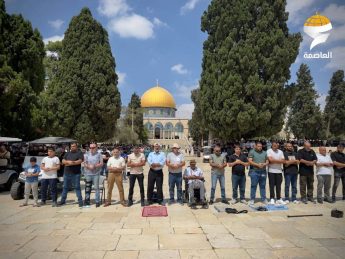The Jerusalemite citizen Emad Abu Khadija rejected all the Israeli financial offers he has received in exchange for the archaeological treasure he discovered in his shop in Occupied Jerusalem with the aim of protecting it from Israel’s greed.
Abu Khadija who recently discovered ancient ruins behind his old shop near al-Silsila Gate in the Old City of Jerusalem hopes to turn his shop into a restaurant whose profits will be donated to al-Aqsa Mosque and all those in need in his city.
He found the archaeological treasure about 30 years ago when he decided to expand his 80-year-old shop which was owned by his father and grandfather before doing the excavations himself.
In an interview with the PIC Abu Khadija said that the Israeli authorities are attempting to force him to give up his shop. Six years ago Israel’s Antiquities Authority crews broke into Abu Khadija’s shop ordered a halt to the excavations and fined him $10000.
Israeli pressures
Despite the Israeli pressures Abu Khadija continued with the help of Palestinian lawyers he was able to win a court decision to resume work in the shop after six years of suspension in the presence of an employee of the Antiquities Authority to oversee the excavations. Abu Khadija noted that he had to pay 100000 shekels.
The Jerusalemite man revealed that he discovered a series of tunnels leading to al-Aqsa Mosque al-Buraq Wall and the Church of the Holy Sepulchre. He added that he was offered $24 million in exchange for these tunnel but he rejected the offer and decided to turn the shop into an Islamic Waqf (endowment).
“Jerusalem has many treasures that must be protected from the Israeli occupation” he stressed.
Unique shop
Abu Khadija said that the Antiquities Authority crews told him that his shop is the only one of its kind in the Old City. Each and every stone in the shop tells a different story of the Islamic history he explained.
According to historical accounts it is likely that Abu Khadija’s shop is located on a site that was used for economic purposes. The excavations unveiled halls with barrel shaped roofs and a series of bridges believed to be from the Crusader or the Ayyubid era supported by strong pillars and stones and used as stores.
The lower part of the site has bridges of different shapes dating back to the Byzantine or early Islamic period.














